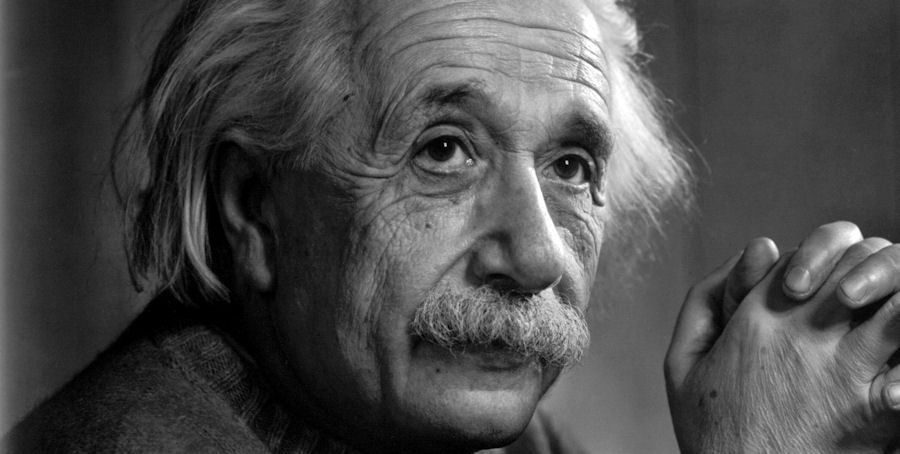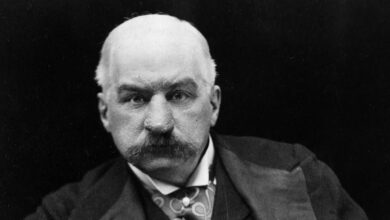
“The difference between stupidity and genius is that genius has its limits.” – Albert Einstein
Podcast: Play in new window | Download
Subscribe: Spotify | Amazon Music | Youtube Music | RSS
Albert Einstein Biography
Albert Einstein was born into a non-observant Ashkenazi Jewish family on 14 March 1879 in Ulm a city on the River Danube in what was then the Kingdom of Württemberg, in the German Empire. It is now in the German state of Baden-Württemberg. His parents were Pauline Koch and Hermann Einstein who was an engineer and a salesman.
Not long after Albert was born, in 1880, the Einstein family moved to Munich where Hermann and his brother Jakob founded a company which manufactured electrical equipment. From the age of five, Albert attended a Catholic school in Munich and transferred to the Luitpold Gymnasium three years later. He continued his primary and secondary education there for the next seven years.
In 1894, the Einstein family were forced to relocate again due to the failure of Hermann and Jakob’s business. They headed to Italy, first to Milan and then to Pavia but Albert stayed behind in Munich to complete his studies. He became more and more frustrated with the gymnasium’s method of teaching though and he clashed with the authorities there and so when the family moved to Pavia, he joined them in December 1894.
The following year, at the age of sixteen, Albert Einstein sat but failed the entrance exam for entry into the Swiss Federal Polytechnic in Zurich. It was noticed though that it was the general studies part of the exam that performed poorly on, whereas his performance on the physics and mathematics parts was excellent. So, he became a pupil at the Argovian cantonal school in Aarau instead, which is where he completed his secondary education.
In January 1896, in order to avoid military service, Albert Einstein renounced his citizenship of the Kingdom of Württemberg and in September of the same year, he passed the Swiss high school exit exam, the Matura, with passable grades. At the age of only seventeen, he then enrolled in a four-year teaching diploma in physics and mathematics at Zurich Polytechnic.
During his time in Zurich Albert Einstein also met his future wife, Mileva Marić who had enrolled on the same course. In 1900, Einstein was awarded his diploma, but Mileva failed the mathematics portion of the exam.
After graduating, Einstein looked for a teaching post. In 1901, he became a Swiss citizen and took a job as an assistant examiner – level III at the Federal Office for Intellectual Property where he evaluated patent applications. After searching for a teaching post for two years and failing to find one, the patent office job became permanent in 1903.
Letters between Albert Einstein and Mileva which were discovered in 1987 reveal that the couple had a daughter in 1902 while Mileva was staying with her parents in Novi Sad in Serbia. However, when she returned to Switzerland she came without the child and its fate is unknown but it is believed she was either adopted or died of scarlet fever.
Albert Einstein and Mileva Marić were married in January of 1903 and in May 1904, Hans Albert Einstein, their first son was born in Bern, Switzerland. Eduard, their second son was born in Zurich in July 1910. The family moved to Berlin but it was to become apparent, that Albert had fallen in love with his first cousin, Elsa. Mileva moved back to Zurich and after five years apart, they divorced in February 1919. The same year, Albert Einstein and Elsa were married.
On 30 April 1905, completed his thesis with his Pro-forma advisor Alfred Kleiner and a dissertation entitled “A New Determination of Molecular Dimensions”, and was awarded a PhD from the University of Zurich. In the same year, which would become known as his miracle year or annus mirabilis Einstein, at the age of only 26 published four papers that brought him to the attention of the academic world. The four papers covered the photoelectric effect, the equivalence of mass and energy, Brownian motion and special relativity.
From this point on his star began to rise and by 1908 he had been appointed lecturer at the University of Bern. The following year, he was appointed an associate professor in theoretical physics. In 1911 he was made a full professor at the Charles-Ferdinand University in Prague accepting Austrian citizenship in the process. In 1912 he returned to Zurich and became a professor of theoretical physics. Two years later, he returned to the German Empire when he was made the director of the Kaiser Wilhelm Institute for Physics as well as a professor at the Humboldt University of Berlin. In 1916 the German Physical Society appointed him as its president.
In 1919 Albert Einstein became known to the whole world when the calculations that he had made in 1911 that showed that light from another star should be bent by the sun’s gravity were observed and confirmed during a solar eclipse.
In 1921 Einstein visited the United States and visited New York City and Washington and spent three weeks giving lectures including ones at Columbia and Princeton Universities. Following his trip to the USA, he visited London and gave a lecture at King’s College. Also in 1921, he was approached by Chaim Weizmann, president of the World Zionist Organisation to help raise funds for a planned Hebrew University of Jerusalem. He did so, and the university opened in 1925 with Einstein being one of the first members of its Board of Governors.
In 1922, Albert Einstein was awarded the Nobel Prize in Physics and toured Aisa and visited Palestine during the same year. In 1925 he received the Copley Medal from the Royal Society.
In December 1930, Einstein and his wife, Elsa visited the USA for a second time, this time keeping his visit as low key as possible. He was invited to lecture and speak at various events but he turned them all down. During his trip, he visited New York’s Chinatown and took part in a Hanukkah celebration in Madison Square Garden. He also visited California and Carl Laemmle, Head of Universal Studios introduced him to Charlie Chaplin and the two instantly became friends.
After another visit to the United States in 1933, Albert Einstein and Elsa returned to Europe by ship, arriving in Antwerp, Belgium on 28 March, where he learned that their home had been raided by the Nazis. Einstein knew that he could not return to Germany due to the rise of the Nazi party and its leader Adolf Hitler and so went to the German consulate, handed in his passport and renounced his German citizenship.
Einstein first lived in Belgium for a short while before moving to England where he met Winston Churchill and former British prime minister David Lloyd George. He asked for their help to get Jewish scientists who had been banned from working in German universities out of Germany. Churchill immediately did so, finding positions in British universities for many.
In 1935, though, Albert Einstein decided that America was where he wanted to be and so he moved there and became a member of the Institute for Advanced Study and attempted, unsuccessfully, to develop a unified field theory.
In July 1939 he was approached by physicists Leó Szilárd and Eugene Wigner who explained their ideas about atomic bombs and their use as well as the fact that they believed the Nazis were actively trying to make one. They believed it was their duty to ensure that America was alert to the prospect but that so far they had been unsuccessful. They asked Einstein to use his influence to help, which he did by signing a letter to President Roosevelt, who subsequently threw every resource he could at what would become the Manhattan Project. Shortly afterwards, in 1940, Albert Einstein became an American citizen.
Albert Einstein was passionately involved in the battle to combat racism in the United States which he referred to as its greatest disease. He joined the NAACP and campaigned for civil rights and in 1946 he visited Lincoln University in Pennsylvania and was awarded an honorary degree from what was a historically black college. In 1951 he offered to testify as a character witness on behalf of the civil rights activist W. E. B. Du Bois, and as soon as he did so, the judge dismissed the case.
In 1948, Albert Einstein underwent surgery to reinforce an abdominal aortic aneurysm but on 17 April 1955, it ruptured, causing internal bleeding. He refused further surgery and died at Princeton Hospital the next morning. He was 76 years old.
Throughout his life, Albert Einstein published more than 300 scientific papers and more than 150 that were not related to science. He also published hundred of articles and books. His name has become synonymous with the word ‘genius’. In 2014, 30,000 unique documents, written by Einstein, were released by various universities and archives, giving scientists plenty of work to do, if they are to figure out what made Einstein tick.
Podcast: Play in new window | Download
Subscribe: Spotify | Amazon Music | Youtube Music | RSS




